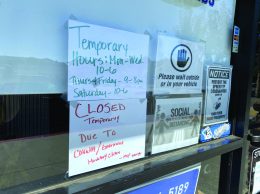Opinion: Source of labor shortage not so simple
By Bruce Stenslie
We all know from the shared experiences of employers across a wide range of industries and business models that it’s become an enormous challenge to hire the workers needed to keep up with demand as the economy re-opens.
We know too that the most commonly presumed cause for the worker shortage is an overly generous unemployment insurance and other pandemic disaster payouts that appear to make it more lucrative to stay at home.
I think it is important to lay out a more complete and nuanced set of variables surrounding this issue. So, knowing no one yet has the full and perfect story, here’s a shot:
First, the challenge in hiring is only one manifestation of a stunning, once-in-a-lifetime (we hope) disruption in labor markets and the larger economy. Current research, for example, shows that fully 1 in 3 workers either changed or lost employment in the last year. We call this turnover “churn”; there’s a high rate of it even in good times. But this 1 in 3 rate is unprecedented, and it’s going to take some time for the market to settle out.
We’re just starting to re-open many businesses. A quick and efficient sorting of the enormously complicated interrelationships between business and labor, between business demand and labor supply, just isn’t in the cards. Patience is hard but needed.
For a more direct look at cause and effect on the challenge to hire, there are literally hundreds of articles in the academic journals and press that address the following:
1. Yes, unemployment benefits are a partial contributor, but there’s a ton of data that shows this presumably obvious cause for workers staying at home isn’t singly true. No doubt there are some who will take advantage, but the evidence is workers want to work; workers know the benefits don’t last forever. The research does not consistently show a correlation between size or duration of unemployment compensation and beneficiaries eschewing work.
Further, it’s important to remind that it’s unfair to vilify workers or labor as a class. Federal, state and local policymakers delivered an enormous cache of benefits to both sides of the labor equation, business and workers. Both sides have abused it to some extent, but both sides needed it to survive. Were it not for the billions in unemployment insurance and direct payments to families, businesses would have collapsed at a far greater rate, as there would have been a shortage of money to spend at those that did remain open.
2. Another more certain cause, for which there is data to support, is women staying home to care for kids. Schools aren’t fully re-opened, there’s a lack of available child care and women are still disproportionately left with this responsibility in the home. In response to this crisis, there’s a mountain of money being allocated, federal and state, to child care and early child education, but it’s only just starting to get out. This is an important and long-needed investment, but its impact on hiring will take time.
3. Workers are cautious about returning to jobs that put them in close contact with customers or other workers. COVID-19 is real, its impacts devastating. Overcoming this anxiety is going to take time — and a continuing trend for improved health outcomes.
4. Workers are returning to the labor force, but with all the churn, they’re not going back to the same employers or even the same industries. One indicator of this is the number of employers who say the workers they had before the pandemic aren’t coming back now that they’ve re-opened. They may have found other jobs, higher wages, more accommodating schedules and better working conditions. Though certainly that’s a problem for the businesses struggling to hire, it’s what we’d expect of workers in a free-market economy.
The hard lesson in all of this is that after disaster we don’t just return to the pre-disruption “normal.” We’re not seeing changes only in hiring. Rather, we’re seeing all sorts of transition and innovation in business and labor relations and in business models: accelerating rates of automation, new opportunities for remote work, more e-commerce. Though miserable while we are in the throes, these changes may over time turn out to be good for both business and labor.
Tragically, of course, the gains and losses aren’t evenly distributed. Office and professional workers and businesses fared relatively well, while workers and businesses in retail, hospitality and other services suffered disproportionately. Low-income, women and minority workers lost the most. As these workers in particular seek to re-enter the labor force, let’s understand that they’re on the front lines of pandemic recovery, struggling to earn the incomes needed to live here and navigating the most radical and far-reaching disruption of work and business in our lifetimes.
• Bruce Stenslie is president and CEO of the Economic Development Collaborative of Ventura County.












